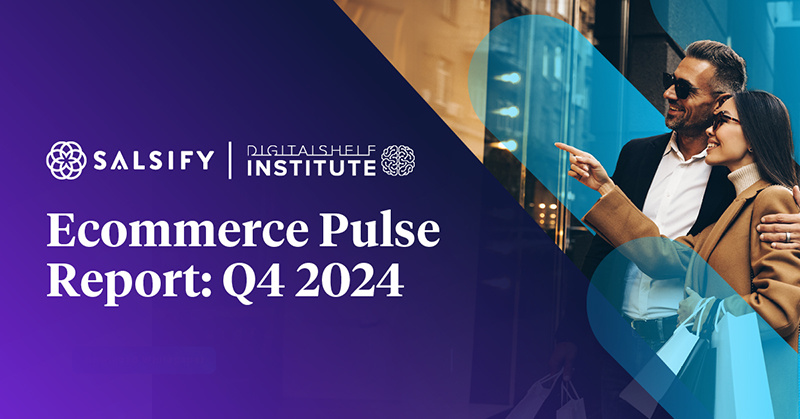New Consumer Research: How Do Shoppers Feel About Personalization in Ecommerce?

There’s nothing worse than scrolling past hundreds of products you wouldn’t touch with a 10-foot pole to find what you need.
This was the shoppers’ reality pre-personalization. But new technology, powerful algorithms, and easier access to consumer data have helped brands transform mundane shopping trips into tailor-made adventures.
The question is: Is this what consumers want? Are they happy to exchange their data for personalized experiences? The “Ecommerce Pulse Report: Q4 2024” from Salsify and the Digital Shelf Institute (DSI) dives into the realities of personalization in ecommerce, whether it’s a yay or a nay for today’s shoppers, and how you can delicately deliver original experiences for every customer.
How Shoppers Really Feel About Personalization in Ecommerce
Personalization in ecommerce is so much more than a name token or a “Hey Susan” in the subject line. It’s an integral part of most shopper’s buying journey. The report found that not only is personalization preferred — but it’s also expected.
More Personalization, More Purchases
According to Salsify and the DSI’s research, 37% of shoppers buy more often due to personalized product recommendations — but there’s a stark split across the generations. Over half (53%) of Generation Z (Gen Zers) are more susceptible to a personalized product recommendation.
That percentage reduces to 48% for millennials, 34% for Generation X (Gen Xers), and a tiny 12% for baby boomers.
We can guess why this may be — boomers have shopped for decades without personalized prompting, whereas Gen Zers have grown up with powerful technologies that can (and do) create unique experiences just for them.
Shoppers Expect Personalization
It’s not just that shoppers buy more when they’re served personalized product recommendations. Many of them expect it. Twenty-two percent of survey respondents say they absolutely expect retailers to deliver personalized shopping experiences.
However, the tables turn a bit here when it comes to who expects it: 29% of Gen Xers, 27% of millennials, and 21% of Gen Zers expect personalized experiences, while only 7% of boomers do.
Shoppers Prefer Brands That Personalize
If you’re worried about the increasing competition, personalization may be the ticket you need to stand out. Sixteen percent of surveyed shoppers say they prefer brands and retailers that offer personalized shopping — something that could be the deciding factor when faced with two brands offering similar products.
Personalized Experiences Are More Enjoyable
It’s no real surprise that shoppers enjoy personalized experiences more than generic ones. Note that 19% of survey respondents say ecommerce personalization makes shopping more enjoyable, whether it’s relevant product recommendations or an entirely personalized post-purchase sequence.
But … Shoppers Have Concerns
It’s not all fun and games. Personalizing the shopping experience hinges on getting a decent amount of shopper data. You need to know who’s buying what to be able to serve relevant, tailored recommendations.
This hasn’t gone unnoticed by shoppers. Per Salsify and DSI research, 19% have concerns about how their data is used for personalization. And again, no real surprise about who’s the most concerned. The most worried generational group is the baby boomers, with 28% of surveyors being concerned about their data. This percentage drops for Gen Xers (17%), millennials (17%), and Gen Zers (15%).
The VIP Experience: How To Create Personalized Retail Journeys
Ready to meet the latest expectations of shoppers from all walks of life? Here are some ways you can personalize the shopping experience.
Personalized Product Recommendations
One of the most effective (and common) ways to personalize the shopping experience is through tailored product recommendations. We’ve all seen this in action on big sites like Amazon that tell us “You might also like … ”, but you can take it a step further and deliver highly relevant suggestions directly to someone’s email inbox.
This kind of personalization works by using artificial intelligence (AI) and machine learning to analyze a customer’s browsing history, past purchases, and demographic data to suggest items that are likely to interest them. If someone’s looked at four product pages for golf clubs, it’s fair to assume they’re interested in golf clubs.
Image Source: Olly
Olly recommends products customers might also like on each product page.
AI-Powered Search
According to the intelligent commerce experience platform Nosto, 69% of shoppers head straight to the search bar when they land on an ecommerce site (and 80% will hotfoot it straight out of there if they don’t have a good experience with it).
This is a great opportunity to create a uniquely tailored experience that helps shoppers find exactly what they’re looking for. Advanced search platforms use natural language processing (NLP) to understand the context and intent behind a shopper’s search query so you can deliver results tied to their wants and needs.
For example, if a customer often searches for eco-friendly products, the search engine can prioritize sustainable options in future searches.
Image Source: Burrow
Burrow uses AI to predict what shoppers will search for.
Dynamic Content and Layout
It seems wild that you can present a totally different website to different shoppers — but it’s possible. You can personalize the entire website experience by dynamically adjusting the content and layout based on each shopper’s preferences and behavior.
In action, this might look like:
- Customizing the homepage to show products or categories that match the shopper’s proven interests.
- Adjusting the order of product listings based on the shopper’s previous interactions on your site.
- Displaying personalized banners or promotional offers for products that shoppers have shown previous interest in.
Tailored Promotions and Offers
According to eMarketer, 62% of U.S. consumers actively look for promo codes, discounts, and coupons when buying online. There’s no better feeling than knowing you’re getting a good deal — but the promotions you serve shoppers don’t have to be monetary based. Research by PYMNT found that 41% of consumers identified free shipping as an extremely important factor when shopping.
Use purchase history and past browsing behavior to create custom promotions for each shopping, such as personalized discount codes for products they’ve shown interest in or bundle deals featuring complementary items to their previous purchases.
Image Source: Simply Be
Fashion brand Simply Be accomplishes this by offering shoppers £30 off if they bought something the previous month.
Personalized Email Marketing
The sale is often just the start of a new customer relationship. Once they’ve tapped that all-important “buy” button, you can swoop in with personalized follow-up content that can help cement their long-term loyalty.
Send targeted emails featuring personalized product recommendations, reminders about abandoned cart items, and personalized content like style guides or how-to articles about the products they’ve bought.
AI-Driven Customer Service
When shoppers are in buy mode, any potential obstacle can put them off. Avoid this by using AI-powered chatbots that can answer real-time questions and provide personalized customer service at scale.
Here’s what this might look like:
- Answering product-specific questions based on a customer’s browsing history.
- Offering personalized styling advice or product recommendations.
- Providing order status updates and handling simple customer service requests.
Image Source: Sol de Janeiro
For example, Sol de Janeiro’s chatbot directs shoppers to products that best fit their needs.
The Shift Toward Personalized in Ecommerce
The research shows that shoppers, especially younger ones, don’t just like personalized experiences — they expect them.
And when online stores get personal, good things happen. People shop more often, they’re happier with their purchases, and they stick with brands they love. But there’s a catch. While customers want that personal touch, they’re also worried about their data and how it’s being used.
So what’s the solution? Focus on personalization that really matters to shoppers. This might mean using AI to suggest products they’ll love, making it easier for them to find what they’re looking for, and even changing up the website based on consumer preferences.

Ecommerce Pulse Report
Want to see what other ecommerce trends consumers are reacting to? Download the latest report to explore the latest consumer and trend insights.
DOWNLOAD REPORTWritten by: Lizzie Davey
Lizzie Davey (she/her) is a freelance writer and content strategist for ecommerce software brands. Over the past 10 years, she's worked with top industry brands to bring their vision to life and build optimized and engaging content calendars.
Recent Posts
Ecommerce Marketing
|
12 minute read
The Art of the Impulse Buy: 70% of Shoppers Say Discounts Drive Unplanned Purchases — Here’s Why
Read More
Ecommerce Marketing
|
10 minute read
What Does It Take To Have a Good Brand Reputation in 2025?
Read More
Ecommerce Trends
|
11 minute read
What Is Commerce Media — and How Can It Optimize Your Marketing Spend?
Read More
Subscribe to the Below the Fold Newsletter
Standing out on the digital shelf starts with access to the latest industry content. Subscribe to Below the Fold, our monthly content newsletter, and join other commerce leaders.
Ecommerce Pulse Report
Want to see what other ecommerce trends consumers are reacting to? Download the latest report to explore the latest consumer and trend insights.
DOWNLOAD REPORT

.svg)